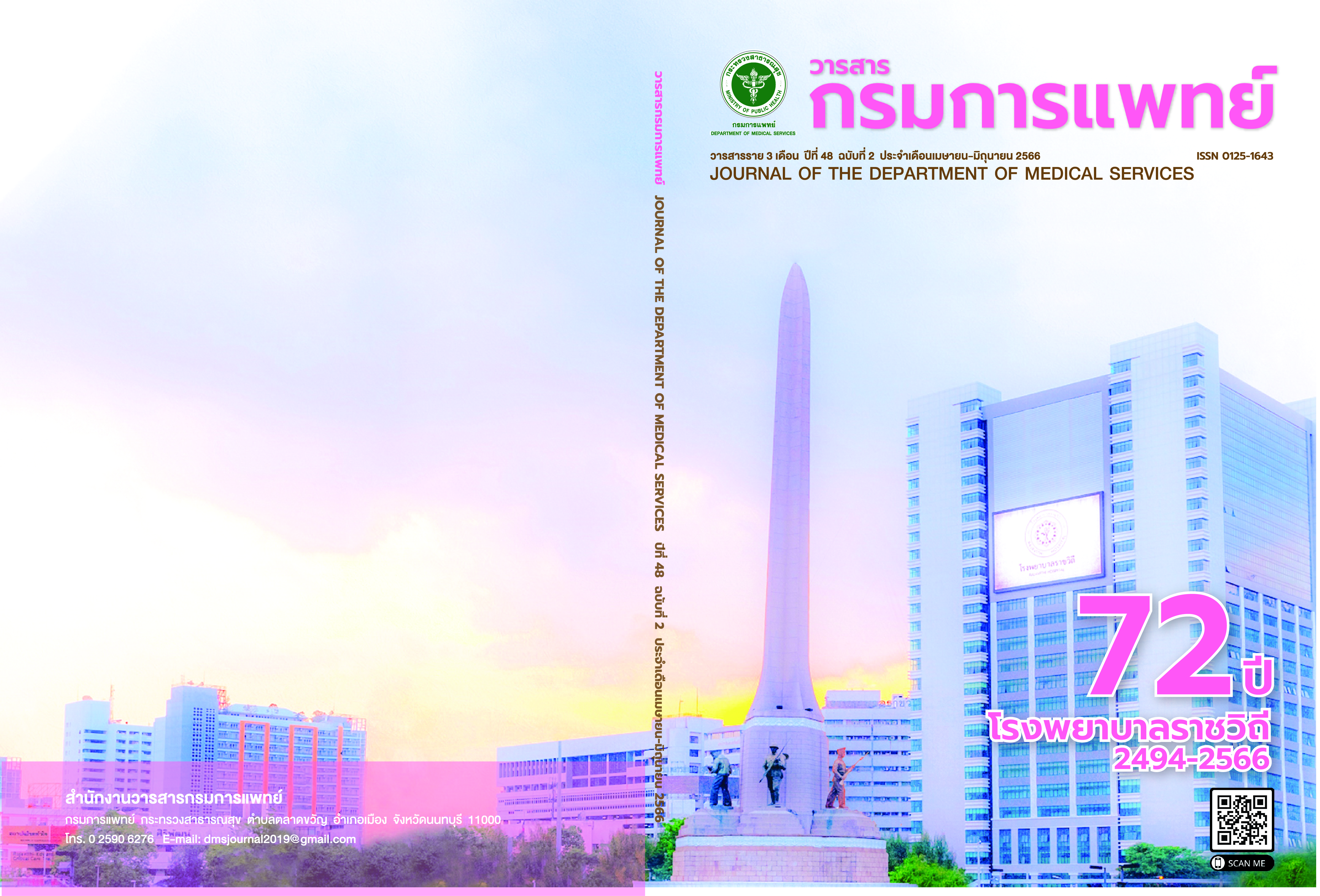The Study of Adverse Reactions of Fundus Fluorescein Angiography and Indocyanine Green Angiography
DOI:
https://doi.org/10.14456/jdms.2023.23Keywords:
Fundus angiography, Fluoresceine, Indocyanine green, Adverse reactionAbstract
Background: Fundus fluorescein angiography (FFA) and/or indocyanine green (ICG) play significant rolesnot only in abnormal investigation but also in the diagnosis and follow-up treatment of retina and choroid. Theinformation from a study of adverse reactions of FFA and/ or ICG will be useful for guideline development. It mayreduce the severity level of FFA and/or ICG adverse reactions. Objective: To determine the severity level andfactors related to the occurrence of adverse reactions. Method: Data were collected from 2,936 medical recordsat Mettapracharak (Watraikhing) Hospital from January 2561 to December 2563, but the present analysis was basedon 2,682 fundus fluorescein angiography patients, who were followed by inclusion criteria. Statistics for analysiswere inferential statistics, chi-square, and odds ratio. Result: The reactions were mild (1.9%) or moderate (1.8%).98 patients (3.7%) who had adverse reactions were male (68.4%), with an average age of 48 years old (SD = 16.05),and without underlying disease (57.1%). Male patients had 1.5 times more adverse reactions than females (OR 1.5,95%CI: 1.005, 2.389, p = .05). Patients with underlying diseases had a lower ratio of adverse reactions than patientsthat did not have underlying diseases (42 VS 56, OR 0.56, 95%CI: 0.370, 0.837, p = .01). The other factors haveshown that there was no significant number of patients with adverse reactions. Conclusion: Male patients had moreadverse reactions than females. Patients with underlying diseases had a lower ratio of adverse reactions than thosewithout underlying disease.
References
Yannuzzi LA, Rohrer KT, Tindel LJ, Sobel RS, Costanza MA,Shields W, et al. Fluorescein angiography complication survey.Ophthalmology 1986; 93(5):611-7.
Yang Y, Mai J, Wang J. Risk factors for adverse reactions of fundusfluorescein angiography. Eye Sci 2016; 31(2):86-91.
Meira J, Marques ML, Falcão-Reis F, Rebelo Gomes E,Carneiro Â. Immediate Reactions to Fluorescein andIndocyanine Green in Retinal Angiography: Review ofLiterature and Proposal for Patient’s Evaluation. Clin Ophthalmol2020; 14:171-8.
Bhurayanontachai P. Fundus Angiography for Diagnosis ofChoroidal Tumors. Songkla Med J 2010; 28(5):275-85.
Daiichi Sankyo Propharma. Daiichi Sankyo submits applicationfor additional indication of Diagnogreen(R) IntravenousInjection. Daiichi Sankyo Propharma 2011.
Su Z, Ye P, Teng Y, Zhang L, Shu X. Adverse reaction in patientswith drug allergy history after simultaneous intravenous fundusfluorescein angiography and indocyanine green angiography.J Ocul Pharmacol Ther 2012; 28(4):410-3.
Nitiruangjarus K. The study of adverse reactions incidence offundus fluorescein angiography. J Nurs Sci 2008; 26(2-3):83-96.
Rattanasukon M. Fluorescein angiography; 2014.
Lira RP, Oliveira CL, Marques MV, Silva AR, Pessoa Cde C. Adversereactions of fluorescein angiography: a prospective study.Arq Bras Oftalmol 2007; 70(4):615-8.
Downloads
Published
How to Cite
Issue
Section
License
Copyright (c) 2023 Department of Medical Services, Ministry of Public Health

This work is licensed under a Creative Commons Attribution-NonCommercial-NoDerivatives 4.0 International License.
บทความที่ได้รับการตีพิมพ์เป็นลิขสิทธิ์ของกรมการแพทย์ กระทรวงสาธารณสุข
ข้อความและข้อคิดเห็นต่างๆ เป็นของผู้เขียนบทความ ไม่ใช่ความเห็นของกองบรรณาธิการหรือของวารสารกรมการแพทย์



